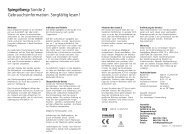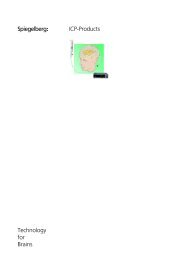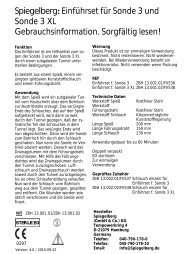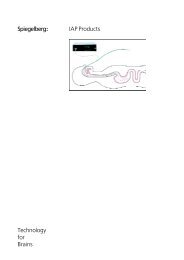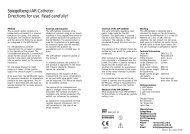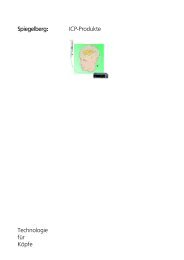Spiegelberg:Sonde 3 / Sonde 3 XL Gebrauchsinformation. Sorgfältig ...
Spiegelberg:Sonde 3 / Sonde 3 XL Gebrauchsinformation. Sorgfältig ...
Spiegelberg:Sonde 3 / Sonde 3 XL Gebrauchsinformation. Sorgfältig ...
Sie wollen auch ein ePaper? Erhöhen Sie die Reichweite Ihrer Titel.
YUMPU macht aus Druck-PDFs automatisch weboptimierte ePaper, die Google liebt.
<strong>Spiegelberg</strong>: <strong>Sonde</strong> 3 / <strong>Sonde</strong> 3 <strong>XL</strong><br />
<strong>Gebrauchsinformation</strong>. Sorgfältig lesen!<br />
Methode<br />
Das Luftkammer-System ist ein Hohlkörper<br />
aus Kunststoff, der über einen<br />
Schlauch mit einem Druckaufnehmer<br />
verbunden ist. Der Druckaufnehmer befindet<br />
sich zusammen mit der Meßelektronik<br />
und einer Vorrichtung zur Füllung<br />
der Luftkammer in dem Hirndruck-<br />
Meßgerät.<br />
Zur intrazerebralen Druckmessung<br />
wird die Luftkammer im Ventrikel oder<br />
im Parenchym des Patienten plaziert.<br />
Der intrakranielle Druck wird über die<br />
dünne Wand der Luftkammer auf die<br />
Luft in der Kammer übertragen und vom<br />
Druckaufnehmer in elektrische Signale<br />
umgesetzt.<br />
Auf dem Display des Gerätes werden<br />
der Mitteldruck und während der ersten<br />
zehn Minuten nach dem Einschalten<br />
auch die Pulsamplitude angezeigt.<br />
Am Monitorausgang stehen sowohl der<br />
Mitteldruck als auch das pulsatile Signal<br />
zur Verfügung.<br />
Das Hirndruck-Meßgerät öffnet den<br />
Druckaufnehmer einmal pro Stunde zur<br />
Atmosphäre und stellt den Nullpunkt<br />
ein. Danach wird die Luftkammer mit<br />
dem Volumen gefüllt, das für die Druckübertragung<br />
erforderlich ist.<br />
Indikation und Funktion<br />
Die <strong>Sonde</strong> 3 dient der Messung des<br />
intraventrikulären Druckes mit einer<br />
Luftkammer, die an der Spitze eines<br />
doppellumigen Katheters angebracht<br />
ist. Ein Lumen überträgt den Druck zum<br />
Hirndruck-Meßgerät. Das zweite Lumen<br />
dient der Liquordrainage. Im Bereich<br />
der Spitze sind zwei Drainagebohrungen<br />
vorhanden. Zwei weitere<br />
Bohrungen befinden sich proximal der<br />
Luftkammer.<br />
Die Plazierung der Meßsonde frei im<br />
Ventrikel sollte bevorzugt werden. Ist<br />
dies nicht möglich, kann die <strong>Sonde</strong><br />
auch im Parenchym plaziert werden.<br />
Die Messung des Liquordruckes stellt<br />
im allgemeinen eine Messung des mittleren<br />
ICP dar und berücksichtigt nicht<br />
die Druckgradienten, die bei lokaler<br />
Drucksteigerung auftreten.<br />
Hinsichtlich der Dauer der Messung<br />
bestehen die bekannten<br />
Komplikationsmöglichkeiten der<br />
Ventrikelkatheter. Entsprechend sollte<br />
die Indikation eng gestellt werden.<br />
Systembedingt kommt es bei dem<br />
stündlichen Nullpunktsetzen und Füllen<br />
zu geringfügigen Änderungen des<br />
intrakraniellen Volumens. Die<br />
Volumenänderungen sind so gering,<br />
daß eine Gefährdung des Patienten sowie<br />
eine Verfälschung der Messung<br />
ausgeschlossen sind.<br />
Im Gegensatz zur Messung über einen<br />
üblichen Ventrikelkatheter wird der ICP<br />
auch bei kollabiertem Ventrikel richtig<br />
gemessen.<br />
Liquordrainage und Druckmessung beeinflussen<br />
sich gegenseitig nicht.<br />
Plazieren der <strong>Sonde</strong> 3<br />
Hinsichtlich der Anlage gelten die gleichen<br />
Prinzipien wie bei der Verlegung<br />
von Ventrikelkathetern zur externen<br />
Liquorableitung. Allerdings ist ein<br />
hochfrontaler Zugang zu empfehlen.<br />
Der mitgelieferte Mandrin kann in das<br />
Drainagelumen eingeführt werden.<br />
Wegen des Luftkammermeßprinzips mit<br />
sterilem Bakterienfilter muß das Einbringen<br />
von Flüssigkeit in das Luftkammersystem<br />
vermieden werden. Zum<br />
Verlegen der <strong>Sonde</strong> durch einen<br />
subgalealen Tunnel empfiehlt sich die<br />
Verwendung eines Trokars.<br />
Die Kanten des Bohrloches sollten<br />
verrundet werden, damit die <strong>Sonde</strong><br />
leichter entfernt werden kann.<br />
Der mitgelieferte Luer-Konnektor dient<br />
zum Anschluß des Drainageschlauches<br />
an ein externes Drainageset. Er wird<br />
auf das Ende des Drainageschlauches<br />
gesteckt. Der Annähflügel des<br />
Konnektors wird an der Kopfhaut befestigt.<br />
Mit Hilfe des geschlitzten<br />
Annähaufsatzes kann sowohl der Luftschlauch,<br />
als auch der doppellumige<br />
Katheter an der Kopfhaut fixiert werden.<br />
Der Konnektor am Ende des Luftschlauches<br />
wird mit dem Hirndruck-<br />
Meßgerät verbunden. Dann wird die<br />
Messung durch Einschalten des Gerätes<br />
gestartet.<br />
Entfernen der <strong>Sonde</strong> 3<br />
Nach Dekonnektion vom Hirndruck-<br />
Meßgerät wird die <strong>Sonde</strong> 3 durch vorsichtiges<br />
Ziehen entfernt.<br />
0297<br />
SND13.1.13/FV532P<br />
SND13.1.13<strong>XL</strong>/FV533P<br />
Warnung<br />
Diese <strong>Sonde</strong> ist zur einmaligen Verwendung<br />
zur Hirndruckmessung mit dem<br />
<strong>Spiegelberg</strong> Monitor HDM 13.x, HDM 26.x<br />
oder HDM 29.x bestimmt. Nicht<br />
resterilisieren. Nicht wiederverwenden.<br />
Bei Wiederverwendung besteht ein<br />
Infektionsrisiko. Niemals Kochsalzlösung<br />
oder ein anderes flüssiges Medium einfüllen.<br />
Nicht verwenden wenn Packung beschädigt.<br />
Technische Daten<br />
Bestell Nr.<br />
SND13.1.13<br />
Material<br />
Tecoflex<br />
Füllvolumen<br />
0,05 - 0,1 ml<br />
Außendurchmesser 2,3 mm<br />
Innendurchmesser 1 mm<br />
Drainage<br />
Länge des doppel- 130 mm 130 mm<br />
lumigen Katheters mit<br />
röntgendichtem Streifen<br />
Länge des einlumigen 150 mm 150 mm<br />
Drainageschlauches<br />
Länge des einlumigen 1370 mm 1370 mm<br />
Luftschlauches<br />
Markierungen 50 mm<br />
Anwendungsdauer<br />
75 mm<br />
kurzzeitig<br />
bis zu 30 Tagen<br />
Inhalt der Originalverpackung<br />
Doppelt verpackt 1 <strong>Sonde</strong> 3<br />
EO sterilisiert 1 Luer-Konnektor<br />
mit Annähflügel<br />
Zur einmaligen 1 geschlitzter<br />
Verwendung Annähaufsatz<br />
1 Mandrin<br />
1 Stopfen<br />
Hersteller<br />
<strong>Spiegelberg</strong><br />
GmbH & Co. KG<br />
Tempowerkring 4<br />
21079 Hamburg<br />
Telefon: 040-790-178-0<br />
Telefax: 040-790-178-10<br />
Email: Info@<strong>Spiegelberg</strong>.de<br />
SND13.1.13<strong>XL</strong><br />
Tecoflex<br />
0,05 - 0,1 ml<br />
3 mm<br />
1,6 mm<br />
50 mm<br />
75 mm<br />
Version: 8.1 / 2013-05-31
<strong>Spiegelberg</strong>: Probe 3 / Probe 3 <strong>XL</strong><br />
Directions for use. Read carefully!<br />
Method<br />
The air-pouch system consists of a<br />
hollow body connected to a pressure<br />
transducer by tubing. The pressure<br />
transducer, the electronic hardware,<br />
and the device for filling the air-pouch<br />
are integrated in the Brain-Pressure<br />
Monitor.<br />
For intracerebral pressure<br />
measurement the air- pouch is placed<br />
in the ventricle or in the parenchyma of<br />
the patient. The intracranial pressure is<br />
transmitted across the thin pouch wall<br />
to the air volume in the pouch and<br />
transformed into an electric signal by<br />
the pressure transducer.<br />
On the digital display the mean<br />
pressure is shown. At the monitor<br />
output both the mean pressure and<br />
the pulsatile signal are available.<br />
Once every hour the Brain-Pressure<br />
Monitor opens the pressure transducer<br />
to atmospheric pressure for zero<br />
adjustment. The air-pouch is then filled<br />
with the exact air volume required for<br />
accurate pressure transmission.<br />
Function and Indication<br />
Probe 3 measures intraventricular<br />
pressure using an air-pouch mounted<br />
in the tip region of a dual lumen probe.<br />
One lumen transmits the pressure to<br />
the Brain-Pressure Monitor. The second<br />
lumen is used for drainage of CSF.<br />
There are two drainage holes in the tip<br />
region and two holes proximal of the<br />
air pouch.<br />
Probe 3 should be placed in the<br />
ventricle. The measurement of pressure<br />
in the parenchyma is also possible.<br />
The ventricular pressure is equivalent<br />
to the ICP. Pressure gradients, however,<br />
cannot be recorded.<br />
Depending on the duration of the<br />
measurement, the same complications<br />
as are seen with ventricle catheters<br />
can be expected. Therefore, the<br />
indication should be considered<br />
carefully.<br />
The volume of the intracranial space is<br />
changed when the system fills the probe.<br />
The increase of volume is negligible<br />
and neither endangers the patient nor<br />
influences the pressure.<br />
As opposed to measurements via CSF<br />
coupled pressure transducers, ICP is<br />
still transmitted in the case of slit<br />
ventricles.<br />
There is no interference of drainage<br />
and pressure measurement.<br />
Insertion of Probe 3<br />
The same principles regarding ventricle<br />
catheters for the external CSF drainage<br />
apply for the Probe 3. A high-frontal<br />
approach is recommended. The stilette<br />
fits into the drainage lumen. Due to the<br />
principle of the air-pouch with an airfilter<br />
in the connector, the contact of<br />
the air-system with liquids is to be<br />
avoided strictly. The use of a trocar for<br />
pushing the probe through a subgaleal<br />
tunnel is recommended. The edge of<br />
the burr-hole should be slightly<br />
rounded in order to enable the removal<br />
of the probe.<br />
The Luer connector is slipped into the<br />
drainage lumen. The connector is fixed<br />
to the scalp by means of its suturing<br />
wing. The butterfly suture clamp can be<br />
used to fix either the air tube or the<br />
dual lumen catheter. The connector at<br />
the end of the air lumen is inserted into<br />
the socket of the Brain-Pressure Monitor.<br />
Pressure measurement is started by<br />
switching on the monitor.<br />
Removal of Probe 3<br />
After deconnection from the Brain-<br />
Pressure Monitor the probe is removed<br />
by carefully pulling it through the<br />
subgaleal tunnel.<br />
SND13.1.13/FV532P<br />
SND13.1.13<strong>XL</strong>/FV533P<br />
Warning<br />
This probe is designed and is intended for<br />
single use for the measurement of ICP with<br />
the <strong>Spiegelberg</strong> Monitor HDM 13.x, HDM<br />
26.x, or HDM 29.x. Do not resterilize. Do<br />
not reuse. With reuse an infection risk<br />
exists. Do not fill with saline or other liquid<br />
media. Do not use if package is damaged.<br />
Technical Information<br />
Order No.<br />
SND13.1.13<br />
Material<br />
Tecoflex<br />
Filling Volume 0.05 - 0.1 cc<br />
Outside Diameter 2.3 mm<br />
Inside Diameter for 1 mm<br />
Drainage<br />
Dual Lumen Length 130 mm<br />
with Radiopaque Stripe<br />
Single Lumen Length 150 mm<br />
(Drainage)<br />
Single Lumen Length 1370 mm<br />
(Air-System)<br />
Depth Marks 50 mm<br />
75 mm<br />
Duration of use<br />
short term<br />
not more than 30<br />
days<br />
Package contains<br />
Double Packed 1 Probe<br />
EO Sterilized 1 Luer Connector<br />
For Single Use 1 Butterfly Suture Clamp<br />
1 Stilette<br />
1 Cap<br />
Manufacturer<br />
<strong>Spiegelberg</strong><br />
GmbH & Co. KG<br />
Tempowerkring 4<br />
21079 Hamburg<br />
Germany<br />
Phone: +49-40-790-178-0<br />
Fax: +49-40-790-178-10<br />
Email: Info@<strong>Spiegelberg</strong>.de<br />
SND13.1.13<strong>XL</strong><br />
Tecoflex<br />
0.05 - 0.1 cc<br />
3 mm<br />
1.6 mm<br />
130 mm<br />
150 mm<br />
1370 mm<br />
50 mm<br />
75 mm<br />
0297 Version: 8.1 / 2013-05-31





